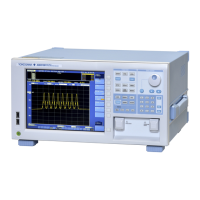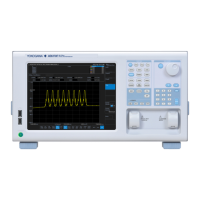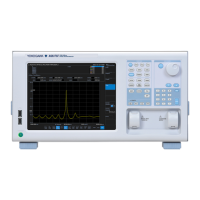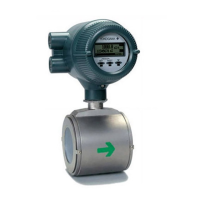2-4
IM AQ6370D-01EN
Switching between Vacuum Wavelength and Air Wavelength
<<See section 5.2 for the operating procedure>>
This function switches the measured wavelength to either a vacuum wavelength or an air
wavelength.
Measurement can be performed in either air or vacuum wavelength mode.
Switching between Wavelength and Frequency
<<See section 5.2 for the operating procedure>>
This function switches the horizontal axis display to wavelength or frequency.
You can display either the wavelengths or frequencies of marker values and analysis
results.
Averaging <<See section 5.11 for the operating procedure>>
This function performs multiple measurements and displays the average values.
The function is used in cases such as: when the light source’s level is fluctuating; when
measuring a modulated signal of several kHz or less; when the waveform is disrupted
and difficult to measure; when it is necessary to obtain even higher measurement
sensitivity.
Power Density Display <<See section 7.4 for the operating procedure>>
The power per 1 nm is called the power density.
The level axis of the AQ6370D indicates the absolute power per wavelength resolution.
For example, if the resolution is set to 0.1 nm, the power per 0.1 nm will be displayed.
Since the optical spectrum of such devices as a gas laser or a laser diode is narrower
than the wavelength resolution of the instrument, the entire power is accommodated
within the band of a resolution. Therefore, the measured power (peak level) is equal
to the total power of the light source. This instrument has been calibrated to display
accurate power under such conditions.
On the other hand, natural light or lights such as fluorescent lamps or LEDs, have,
in many cases, optical spectrums wider than the wavelength resolution set for the
instrument. Therefore, if the instrument measures these lights, measured power will vary,
depending on the resolution setting.
In order to deal with this issue, the instrument is equipped with the dBm dBm/nm soft key
to allow the level axis displays to switch from the absolute power (dBm, mW, μW, nW,
pW) per resolution to power density (dBm/nm, mW/nm, μW/nm, nW/nm, pW/nm).
In the case of power density displays, a measured value is converted to power per 1 nm.
Therefore, whatever resolution is used for measurement, certain measured values will
always be available.
For information on the use of dBm and dBm/nm, see “Power Density Display” in section
5.2, “Horizontal/Vertical Axis Settings.”
The trace computation function can be used to display the power density in the specified
bandwidth within the range of 0.1 nm to 10 nm (see section 6.8).
Note
Specifications such as level accuracy, measurement level range, and level linearity of the
instrument are provided for the absolute power display.
2.2 Measurement

